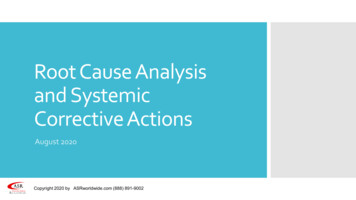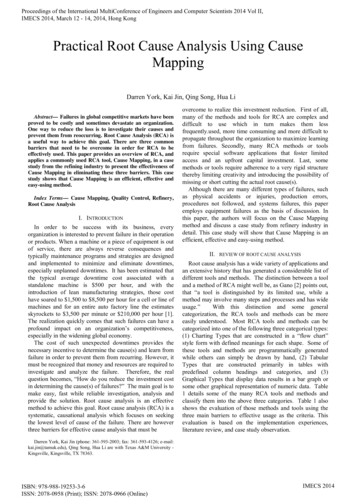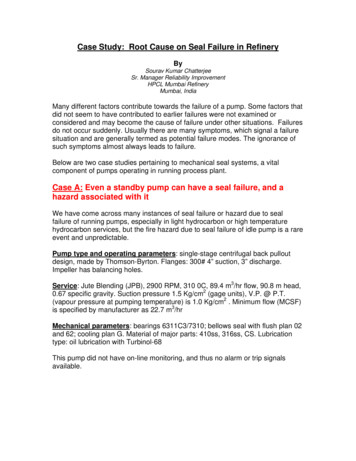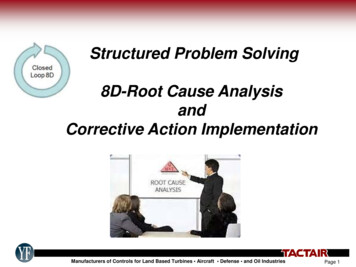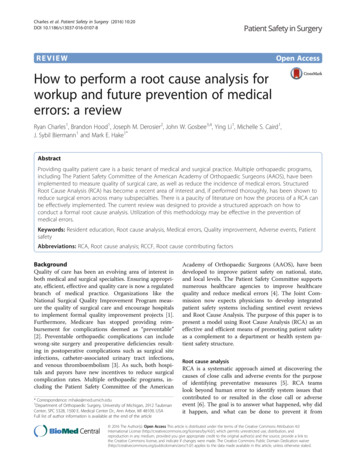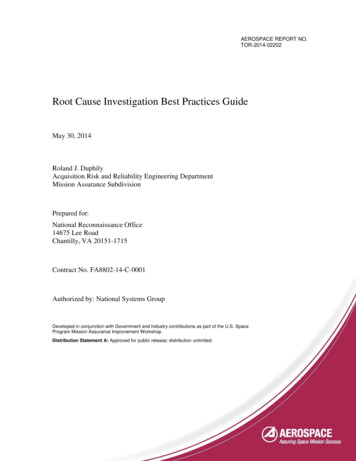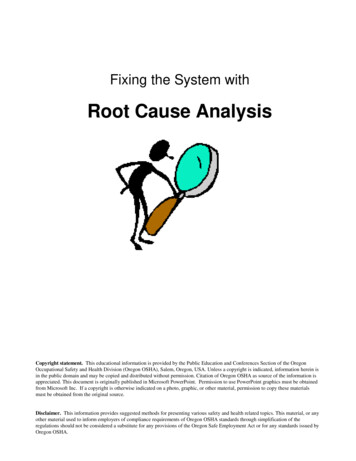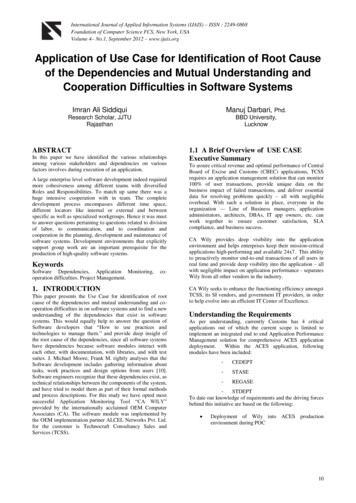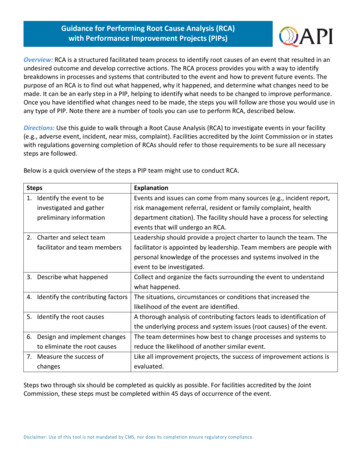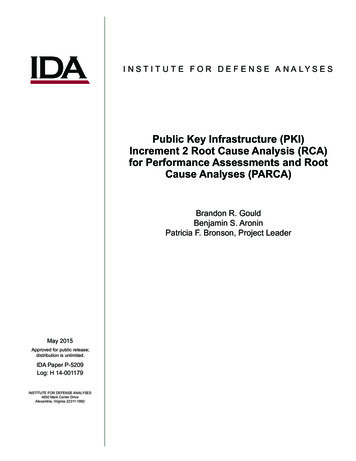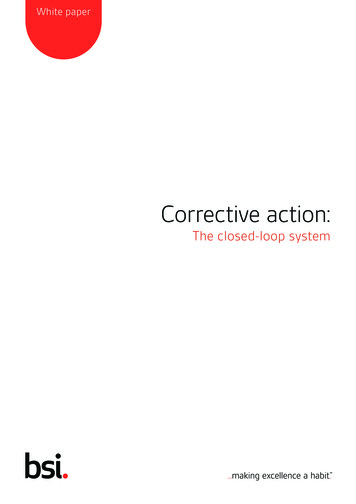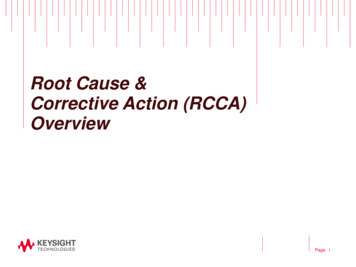
Transcription
Root Cause &Corrective Action (RCCA)OverviewPage 1
Objective To provide guidance to carry out proper Root Cause Analysis(RCA) with suitable quality tools To ensure responded SCAR able to meet Keysight expectationKeysight RestrictedPage 2
IntroductionSupplier Corrective Action Request (SCAR) is a systematicapproach to request investigation of a problem that alreadyhappened and request root cause analysis and resolution fromsupplier to prevent recurrence.Keysight RestrictedPage 3
SCAR Key ElementsStep 1: Problem VerificationStep 2: Containment ActionStep 3: Failure AnalysisSCARStep 4: Root CauseStep 5: Corrective ActionStep 6: Preventive ActionStep 7: Effectiveness VerificationKeysight RestrictedPage 4
Step 1: Problem VerificationProblem verification is the first step of problem investigation. There are 3main activities:a) Verify the problemb) Collect informationc) Describe the problemTo describe the problem specifically, (5W2H) terms (who, what, where,when, why, how, and how many) would help. Example please refer to nextslide.Keysight RestrictedPage 5
Step 1: Problem VerificationExample:What?What happen?Where?When?How much?Probe (Part No.) is found out of specification at Keysight on date X. Total quantity X pcsWhat type of problem?The output current is X when the frequency is X KHz. (specification is X )What?How often?The defective part date code is X. This is the first case reported from customer.5W2HQuestions to askAnswer should be providedWhoWho first observed?Who is affected?- Location of defect foundWhatWhat type of problem?What has the problem?What is happening?- Failure reported- Part No./ Model- Detail description of failureWhyWhy it is a problem?WhereWhere was the problem observed/ occur?WhenWhen the problem first noticed?- Detail description on the failure andverification done- Date code of defective partHow much/ many involved?- Quantity affectedWhat is the trend? Has the problem occurredpreviously?- Failure historyHow much/manyHow oftenKeysight RestrictedPage 6
Step 2: Containment ActionContainment action is to limit a problem extent while continue normaloperation until the root cause is defined and permanent correctiveaction is implementedThe containment area should cover: Production Finished goods Customer (Keysight) Incoming material Warehouse StorageNotes: Affected date code/ serial number should be clearly identified and stated.Keysight RestrictedPage 7
Step 2: Containment ActionActivities: Stoppage of production or shipment Segregation goods on pass or fail Additional visual control Informing customer about the problem Informing operators about the problem Check on similar product or processes if there is similar riskExample:100% screening is done for below area:Supplier’s production (xx pcs), warehouse inventory (xx pcs)Keysight inventory including production (xx pcs), warehouse (xx pcs),Results: xx pcs out of total xx pcs is found with similar reject. The reject rate is xx%.Confirmed the affected date code is x. Rejected part is sent back for further FA.Keysight RestrictedPage 8
Step 3: Failure AnalysisFailure analysis (FA) is the process of collecting and analyzing datato determine the cause of a failure.Failure Analysis can be carry out by various methods including visualinspection, electrical testing and physical testing.Keysight RestrictedPage 9
Step 3: Failure AnalysisExamples:Visual InspectionPhysical Testing Bare eye inspection Drop test Optical microscope Bending test X-ray microscope Pull testElectrical Testing Voltage measurement data Resistance measurementKeysight RestrictedPage 10
Step 4: Root CauseRoot cause identification is the most important step. The problem will besolved only if the corrective action implemented is addressing the real rootcause accurately.Root Cause Analysis (RCA) is a systematic approach to identify the actualroot causes of a problem. Below are the tools frequently used in RCA. 5 Whys Analysis Fishbone Diagram (Cause and Effect Diagram)Notes:The RCA should identify root cause for both Occurrence (Why it occur?) Detection (Why it can’t be detect?)Keysight RestrictedPage 11
Step 4: Root Cause5 Whys Analysis ToolsThis is a continuous question-asking technique used to explore the cause-andeffect relationships underlying a particular problem.General Flowi.Define the problem.ii.Ask Why the problem happen and write down the answeriii. Validate the answer is it the real root causeiv. If no, Repeat step 3 until problem’s root cause is identified.Keysight RestrictedPage 12
Step 4: Root CauseExample of 5 Whys Analysis ToolsAddressingthe trueroot cause ?Why 1: Why wrong part shipped to customer?.Answer:Wrong part was pull from the inventoryRetrain the stock picker- almost no benefit.The real cause is come from mislabel from supplierWhy 2Answer: The part was mislabeledPerform inspection on inventory- minimum benefitApply to on hand inventory onlyWhy 3Answer: Our supplier mislabeled the part beforeship to the warehouseContain the problem by sorting out the mislabel part-very limited long term benefitWhy 4Answer: Operator at supplier site took the otherlabel and placed at the productConduct training for operator – limited long termbenefitWhy 5Answer: Many labels with different order wasprinted at the same location everyday so it iseasy to cause mislabeledMistake proof printing label process or application –highly effectiveKeysight RestrictedPage 13
Step 4: Root CauseFishbone Diagram (Cause and Effect Diagram)A fishbone diagram is a visualization tool for categorizing the potential causes of aproblem in order to identify its root causes.General Flow:i.Define the problemii.Identify the key causesiii. Brainstorm the causesiv. Validate the identified root cause causes.Keysight RestrictedPage 14
Step 4: Root CauseExample of Fishbone Diagram (Cause and Effect Diagram)1. Identify potential root causeMachineCauseManEffectNo propercommunicationToo heavyNot capableNo attend trainingNot rator handdirty/oilyLack ofunderstandingQualityProblemNo agreementwith supplierMaterialdefectiveNot approvedby vendorNot updateLack ofresourcesWrongspecificationNo standardworkPerception noneedTooComplicatedWI not structuralusedNot availableNo inspectionMaterialMethodKeysight RestrictedPage 15
Step 4: Root CauseExample of Fishbone Diagram (Cause and Effect Diagram)2. Validate identified root causeCategoryManRoot causeValidation / investigationsFindingsTrue /falseHand dirty /oilyOperator’s hand aredirty.Parts found with fingerprint mark on surfaceduring processTRUEKeysight RestrictedPage 16
Step 5: Corrective ActionCorrective action (CA) is to remove the root cause and prevent aproblem from ever happening again.The corrective action should correspond to the root cause identifiedearlier in order to eliminate the real root cause and prevent recurrenceof the problem.Method such as brainstorming is recommended as it can help to selectappropriate corrective action for identified root cause.Keysight RestrictedPage 17
Step 5: Corrective ActionExamples:For root cause of “Why problem occur?” Introduce additional process control Introduce new processFor root cause of “Why not detected?” Introduce new testing gate Enhance previous testing coverageKeysight RestrictedPage 18
Step 6: Preventive ActionPreventive Action are proactive and focused on a potential problemin the future.Corrective actions is only a temporary solution that keeps the systemrunning, but a permanent solution is needed to avoid similar problemsfrom occurring into the system again.Keysight RestrictedPage 19
Step 6: Preventive ActionExamples: Changing the process parameter Changing procedure Changing documentation or specification Changing of process or tools Modified or make proper jigKeysight RestrictedPage 20
Step 7: Effectiveness VerificationAfter the corrective and preventive actions are implemented, theeffectiveness should be validate.The key to verification is evidence. This evidence usually takes theform of data, records or first-hand observations.It is recommended the verification made by monitoring the quality ofnext deliveries.Keysight RestrictedPage 21
Step 7: Effectiveness VerificationExamples: Product acceptance rate Test or control results showing improvement Engineering measurement (Dimension and appearance) accordingto specification and tolerance Suppliers deliver goods of better qualityKeysight RestrictedPage 22
SummaryIn conclusion, proper RCA should be conducted in a systematic approach inorder to obtain the real root cause. Besides, effective containment, correctiveand preventive actions correspond to identified root cause should beprovided. Below shows the difference between containment, corrective andpreventive actions.Containment ActionA “first aid” that limit a problem’s extent and establish normal operations untilthe root cause is defined and permanent corrective actions is implementedCorrective ActionActions to remove the root cause and prevent a problem from ever happeningagain. The actions are directed to an event that happened in the past.Preventive ActionPreventive Action are proactive and oriented towards a potential problem in thefuture. They improve a process or a product to remove causes for a potentialproblem and prevent it and related problems from ever happening.Keysight RestrictedPage 23
Appendix:SCARResponse Guideline and ExpectationKeysight RestrictedPage24
SCAR TemplateKeysight RestrictedPage 25
SCAR Response GuidelineCriteriaProcess Step Select root cause Supplier – (category) Category including: Material, Process, Assembly, Testing & documentation Summarize the problem verification, failure analysis, identified root cause andcorrective action in less than 1000 character. Provide clear and precise problem statement Method and condition to duplicate and verify the problem reported. (Refer slide 6) Valid – If is supplier induced failure Invalid –If is Electrical over stress (EOS), No trouble found (NTF), customerapplication and etc. Select proper screening area. If no containment action please provide justification. Screening area including: Production, finished good inventory (FGI), remaining unitswith customer(Keysight) and Unit in field (Other customer). Refer Slide 8 Information needed:Root Cause OptionS0: Overall SummaryS1: Problem VerificationStatusS2: Containment Actiona)Method: Type of screening done in respective area selected aboveb)Results: Reject quantity and ratec)Responsible person named)Date of the action takenKeysight RestrictedPage 26Page 26
SCAR Response GuidelineProcess StepCriteria Briefly summaries the failure analysis (FA) conducted and the results (Includingvisual inspection, Electrical testing and physical testing ) Attach FA report as evidence if available Encourage to perform RCA using proper tool such as 5 Whys analysis andfishbone diagram but not limited to these analysis tools. RCA should emphasize on both area:S3: Failure AnalysisS4: Root Causea)why problem happen (root cause of problem happen)b)why escapee (root cause of problem is not detected ) Summaries the RCA results and categories the real root cause in 4M’s format(Man, Methods, Machines, Materials) Attach RCA report as evidence.Keysight RestrictedPage 27Page 27
SCAR Response GuidelineProcess StepS5: Corrective Action (CA)Criteria List down the corrective action which is correspond to the root cause identified in S4 Provide responsible person and implementation date for each corrective actionOperator re-training/briefing is refrained from being recorded as a correctiveactionContainment action should NOT classified as corrective action.(Please refer slide 9) S6: Permanent CorrectiveAction Permanent Corrective Action (PA) should NOT same as corrective action. Please refer slide 18 & 20 to differentiate between CA and PA. List down the permanent corrective action (preventive) which is correspond to theroot cause identified in S4 Provide responsible person and implementation date for each permanent correctiveactionKeysight RestrictedPage 28Page 28
SCAR Response GuidelineProcess StepCriteria Information should be provided in S7 : Type 2a) Monitoring plan (E.g. type of testing and monitoring area)b) Duration of monitoring (At least 3 months)c) Monitoring start date of the action takend) Responsible person name Type 4a) Monitoring results (Any recurrence?)b) Evidence/ Monitoring data(E.g. Test results, Serial Number/ Lot/Batch No. without similar reject )c) Responsible person nameS7: Verify Effectiveness ofCorrective ActionKeysight RestrictedPage 29Page 29
Thank you!Keysight RestrictedPage30
form of data, records or first-hand observations. It is recommended the verification made by monitoring the quality of next deliveries. Keysight Restricted 21 . Page Step 7: Effectiveness Verification Examples: Product acceptance rate Test or control results showing improvement Engineering measurement (Dimension and appearance) according to specification and tolerance Suppliers deliver
